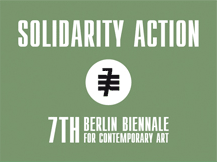Over the last ten years Rome has gone through a period of new ferment, along three main lines. First of all, with the opening of major municipal and state institutions for contemporary art, the result of political pursuit of paradigmatic containers capable of competing with the leading European institutions, at a very high price for the community. For the most part, these new facilities have struggled to find an identity, to create programming and to play a concrete role in the life of the city, beyond the role as propaganda for which they were conceived. Second, there has been a proliferation of non-profit private initiatives of different kinds, driven by a new elite in the city motivated by different objectives. Finally, many new collective experiences have emerged, based on the efforts of a new generation, some of which operate in areas of political thought and activism, while others are more closely connected to the art system.
Starting from an immediately European perspective that shifts between Berlin and Switzerland, we have asked these subjects, in all their variety, to take part in a public discussion, to express their views on certain topics that – in tune with the Berlin Biennial – we feel are urgent in the present situation, regarding: the position of the artist in society; the role of cultural institutions; the economic-social situation experienced by all those who in one way or another contribute to create the cultural scene of our time; the possibility of artists to act to produce real consequences and visible change in the society.
In Europe the movement and debate on contemporary institutions is very lively, as can be observed in the reflections generated by a collective like ESC in Rome and by the Krytyka Polityczna group in Warsaw, which plays an active part in the Berlin Biennial. At the crossroads of three experiments and latitudes – Rome, Switzerland, Berlin – we want to contribute to the debate in which artistic and political practices converge and act, as has happened in the case of the occupation of Teatro Valle, whose effects on the imaginary are widely documented in this publication (as well as recent chronicles).
On the wave of sentiment produced by the #Occupy movements, occupations of spaces are seen today in a new light, even by the conservative press. In Rome another recent example, which we feel is of particular interest, is the occupation of the Cinema Palazzo, which has managed to involve an entire neighborhood and a wide range of its various social components.
If we now observe Switzerland, we notice that its strong roots on a municipal level (though this is a country that has always been perceived in terms of its international character) can represent another interesting direction of research, in which the federalist perspective has an increasing impact on the experimentation of municipal networks in many european cities.
With this publication, we have chosen to place ourselves in the midst of things, where thought and action are inseparable. But we should not overlook the fact that words are never an individual matter; they always fall under the aegis of the whole of the society.
The various subjects operating in the world of art have been a network of scattered individuals for all too long, not constituting an open subjectivity capable of generating cooperation. To spread art does not mean playing the role of commentators, interpreters, critics, biographers, exegetes of mute works that must rely on the devoted witness we bear to their greatness. We have made ourselves into the sworn guardians of a temple whose wonders we boast of using words that close off access to them. P/Act for Art, then, is a tool with which to understand a situation. A tool that is partial, which demands open, public confrontation, with non-neutral positions rooted in a place but with an immediately open, local but not provincial perspective. Because a discussion cannot help but start with definite positions, from a place, a visage, a viewpoint backed by argument and evidence.
This publication is a map we feel is necessary, a possible beginning seen not as an origin, which is always mysterious and divine, but as the first step of an action that has to be pursued. Most new forms, forms of life, forms of art, arise not starting from scratch, but as slowly derived results of a previous form. The tool is gradually adapted, slight modifications are made; the resulting novelty of their combined effects can usually be perceived only at the end, once the words “the end” have been written. But we hope the final word of this publication will be the start of a necessary process of rewriting of the rules, of reform of our institutions, of redefinition of our roles, our common weal, our priorities. A new pact and a new action for art.
SALVATORE LACAGNINA
Head of Arts Programme, Istituto Svizzero di Roma
Curator of the ISR-Solidarity Actions


